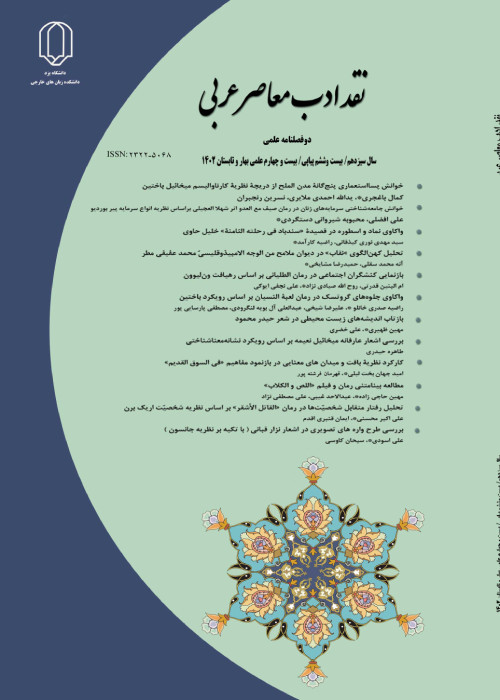A review of the episodic narrative in Hoda Barakat's novel "Barid Al-Layl"
Narrative is the main element in a work of fiction. It takes various forms according its type and approach. One of the important forms of narration in the postmodern novel is the use of episodes in which the novelist, instead of narrating the incident in a macro form, narrates the subject in the form of sub-narratives. It avoids dividing the narrative into traditional elements such as introduction, middle and conclusion. In the postmodern method, the author creates a technical and attractive narrative by focusing on the use of different characters, interactions among narrative levels and conceptual and semantic correlations.In fact, an important function of the novel in recent times has been the use of a new method of narration that is different from traditional and past methods. In this period, the narrative has walked away from its famous and conventional form and is based on contradictions, confusion and disruption of logical rules and natural order among the elements of the story. Therefore, in the postmodern period of the novel, it is not enough to know about a genre or a method to study the narrative; rather, different types and methods of narration should be examined separately. This is because today's fiction, unlike the works of the past that followed certain forms and shapes, is not designed in specific formats and structures; there are general features for narration in the postmodern novel. This form of narrative, which leads to the creation of polyphony, is an important goal of the modern novel, and episodic narrative is a tool to achieve it. An author can create different sounds and narratives by using these two techniques simultaneously.The latest trend in the literature, known as "postmodernism," influenced the Arabic novel. Hoda Barakat is a writer who was influenced by this method in her works, especially in the novel "Barid Al-Layl". She was born in Beirut in 1952 and taught journalism there. Now, she lives in Paris. So far, six novels, two plays, a collection of stories and a self-portrait have been published by this author, and her latest work, entitled "Barid Al-Layl", has attracted the attention of literary circles and won the most important award for Arabic novel. Hoda Barakat's novel "Barid Al-Layl" is the latest work by this prominent Lebanese novelist, which, considering its structure, style and other characteristics, is a unique work that won the Booker Prize for Literature. Using a lettering style, the novel is composed of independent and separate episodes and scenes, but they are related in terms of meaning and concept.Following the various deconstructions and aberrations that have occurred in the postmodern narrative, Barakat turned to new methods, including episodic narrative. In this narrative method, the author avoids using a familiar and traditional macro-structure, and the narrative is divided into sections and subsections. Instead of telling a long and connected story, the novelist uses several micro-incidents or presents the same incident in the form of sub-narratives. An important tool for this technique is the letter-writing style, which was why Hoda Barakat adopted the style of episodic narration in the novel "Barid Al-Layl".Research
By recognizing the type and method of narration in the postmodern novel by Hoda Barakat, this study has examined the components of episodic narration as a tool for this technique. This article is written in a descriptive-analytical manner, and examines the style in the novel using new theories about the postmodern novel.
Hoda Barakat's novel "Barid Al-Layl" makes use of the episodic technique and divided the novel into smaller sections. The author has avoided the grand narrative and avoids heroism and the presentation of extraordinary characters. In order to give his work a novel-like form and to show its difference from the short story, he sticks to semantic attachments and the overlap of narrative levels. In fact, in his episodes, the author has used fragmentary narratives that are connected by certain factors. Hoda Barakat has used five to seven sub-narratives in the novel "Barid Al-Layl". The novel is narrated in episodes and sections, each of which has its own independence. The author has avoided the traditional sequences in the plot. With sub-narratives, he has tried to give objectivity to the depth of the displaced tragedy and to approach reality. This is because showing several characters and several events appropriate to this case enhances the credibility of the events. In spite of such multiplicity and sub-narratives in the theme of homelessness and displacement, Barakat has established unity among the sub-narratives and, through the interference of the narrative levels, has created a temporal connection in spite of a narrative break. Using the episode "At the airport" and the final section "Death of the postman", he has highlighted this connection.
- حق عضویت دریافتی صرف حمایت از نشریات عضو و نگهداری، تکمیل و توسعه مگیران میشود.
- پرداخت حق اشتراک و دانلود مقالات اجازه بازنشر آن در سایر رسانههای چاپی و دیجیتال را به کاربر نمیدهد.



